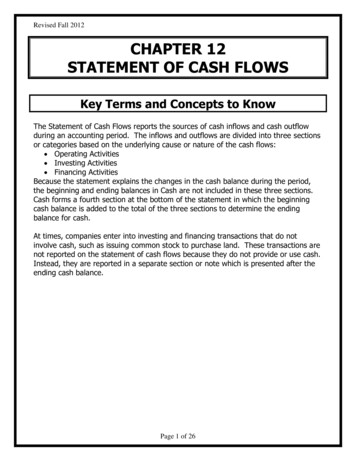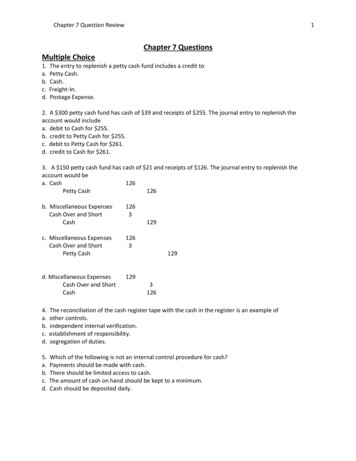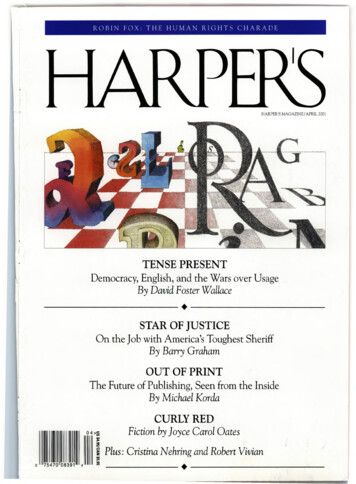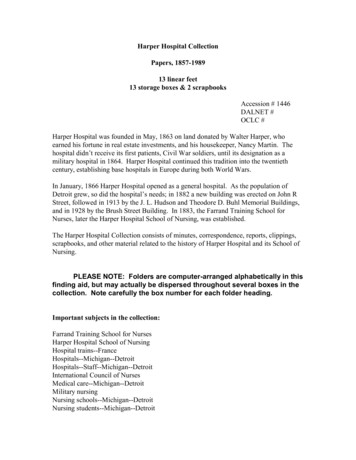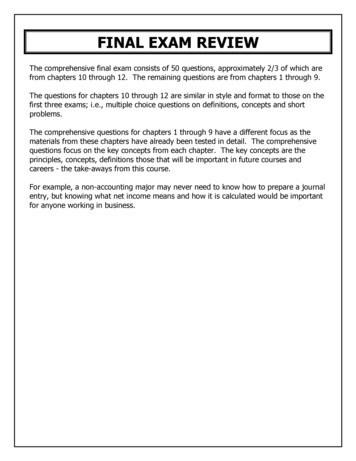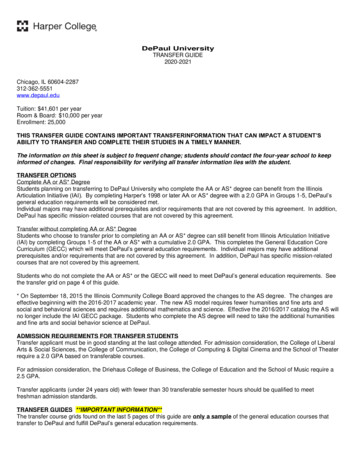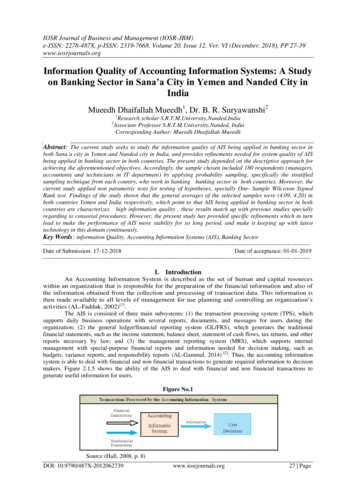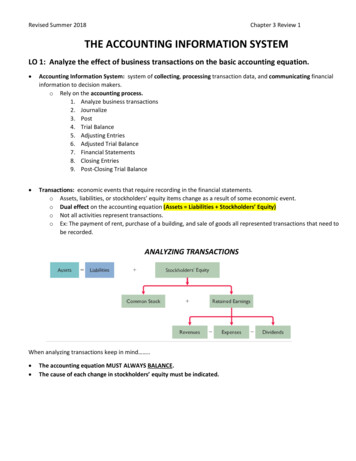
Transcription
Revised Summer 2018Chapter 3 Review 1THE ACCOUNTING INFORMATION SYSTEMLO 1: Analyze the effect of business transactions on the basic accounting equation. Accounting Information System: system of collecting, processing transaction data, and communicating financialinformation to decision makers.o Rely on the accounting process.1. Analyze business transactions2. Journalize3. Post4. Trial Balance5. Adjusting Entries6. Adjusted Trial Balance7. Financial Statements8. Closing Entries9. Post-Closing Trial Balance Transactions: economic events that require recording in the financial statements.o Assets, liabilities, or stockholders’ equity items change as a result of some economic event.o Dual effect on the accounting equation (Assets Liabilities Stockholders’ Equity)o Not all activities represent transactions.o Ex: The payment of rent, purchase of a building, and sale of goods all represented transactions that need tobe recorded.ANALYZING TRANSACTIONSWhen analyzing transactions keep in mind . The accounting equation MUST ALWAYS BALANCE.The cause of each change in stockholders’ equity must be indicated.
Revised Summer 2018Chapter 3 Review 2Example Business Transactions (From Smith Inc.):Keep A L SE in Balance1. Smith Inc. receives 30,000 cash from investors in exchange for common stock.Assets go UP (Cash goes UP)Stockholders’ Equity goes UP (Common Stock goes UP)Assets Liabilities Stockholders' EquityTransaction CashSupplies Accounts Recievable Equipment Accounts Payable 1 30,000Common Stock Revenues - Expenses 30,0002. Smith Inc. pays 4,000 for supplies.Assets go UP (Supplies goes UP)Assets go DOWN (Cash goes DOWN)Assets Liabilities Stockholders' EquityTransaction CashSupplies Accounts Recievable Equipment Accounts Payable 1 30,0002 ( 4,000) 4,000Common Stock Revenues - Expenses 30,0003. Smith Inc. provides consulting services and immediately collects 4,200 cash.Assets go UP (Cash goes UP)Stockholders’ Equity goes UP (Revenue goes UP)Assets Liabilities Stockholders' EquityTransaction CashSupplies Accounts Recievable Equipment Accounts Payable 1 30,0002 ( 4,000) 4,0003 4,200Common Stock Revenues - Expenses 30,000 4,2004. Smith Inc. pays 1,000 cash for employee salary.Stockholders’ Equity goes DOWN (Expenses go UP)Assets go DOWN (Cash goes DOWN)Assets Liabilities Stockholders' EquityTransaction CashSupplies Accounts Recievable Equipment Accounts Payable 1 30,0002 ( 4,000) 4,0003 4,2004 ( 1,000)Common Stock Revenues - Expenses 30,000 4,200 1,000
Revised Summer 2018Chapter 3 Review 35. Smith Inc. provides services of 2,000 and rents its test facilities for 500 to Joe’s Raviolis. Joe is billed 2,500 forthese services and has not paid yet.Assets go UP (Accounts Receivable goes UP)Stockholders’ Equity goes UP (Revenue goes UP)Assets Liabilities Stockholders' EquityTransaction CashSupplies Accounts Recievable Equipment Accounts Payable 1 30,0002 ( 4,000) 4,0003 4,2004 ( 1,000)5 2,500Common Stock Revenues - Expenses 30,000 4,200 1,000 2,5006. Smith Inc. bought 8,000 of equipment on credit from Big Al’s Machine World.Assets go UP (Equipment goes UP)Liabilities go UP (Accounts Payable goes UP)Assets Liabilities Stockholders' EquityTransaction CashSupplies Accounts Recievable Equipment Accounts Payable 1 30,0002 ( 4,000) 4,0003 4,2004 ( 1,000)5 2,5006 8,000 8,000Common Stock Revenues - Expenses 30,000 4,200 1,000 2,5007. Smith Inc. pays BIG Al’s Machine World 3,000 cash towards the payable from transaction 6.Liabilities go DOWN (Accounts Payable goes DOWN)Assets go DOWN (Cash goes DOWN)Assets Liabilities Stockholders' EquityTransaction1234567CashSupplies Accounts Recievable Equipment Accounts Payable 30,000( 4,000) 4,000 4,200( 1,000) 2,500 8,000 8,000( 3,000)( 3,000) 26,200 4,000 2,500 40,700 8,000 5,000Common Stock Revenues - Expenses 30,000 4,200 1,000 2,500 30,000 40,700 6,700( 1,000)
Revised Summer 2018Chapter 3 Review 4LO 2: Explain how accounts, debits, and credits are used to record businesstransactions. Account: an individual accounting record of increases and decreases in a specific asset, liability,stockholders’ equity, revenue, or expense item.o Has 3 Parts: 1) Title of an account 2) A left or debit side 3) A right or credit sideAccountants use “T accounts” to analyze transactions. A “T account” consists of a vertical lineand a horizontal line that resembles the letter T. “T accounts” are helpful when analyzingtransactions.Accounts used in recording transactions have a normal DEBIT or CREDIT balance.*Debit means Left and Credit means Right Normal Balance: The increase side of the account.* An account with a normal DEBIT balance means that we INCREASE that account with a DEBIT. (anddecrease the account with the opposite a credit.)* An account with a normal CREDIT balance means that we INCREASE that account with a CREDIT. (anddecrease the account with the opposite a debit)
Revised Summer 2018Chapter 3 Review 5 An account balance is the difference between the amounts recorded on the two sides of anaccount. If Debits are GREATER than Credits, the account will have a DEBIT BALANCE.If Credits are GREATER than Debits, the account will have a CREDIT BALANCE.The Cash T-Account above has a debit balance of 83,000.Double-Entry Accounting At least 2 accounts are involved, with at least one debit and one credit.DEBITS MUST EQUAL CREDITS.The accounting equation must NOT be violated. (Assets Liabilities Stockholders’ Equity)
Revised Summer 2018Chapter 3 Review 6LO 3: Indicate how a journal is used in the recording process.The Recording ProcessThe Journal Transactions recorded in chronological order in a journal before they are transferred to theaccounts.Contributions to the recording process:1. Discloses the complete effects of a transaction.2. Provides a chronological record of transactions.3. Helps to prevent or locate errors because the debit and credit amounts can be easily compared. A complete journal entry consists of1. The date of a transaction.2. The accounts and amounts to be debited and credited.3. A brief explanation of the transaction.
Revised Summer 2018 Chapter 3 Review 7Example: Entering transaction data into a journal. (From Smith Inc. (cont.)):1. On Jan. 1, Smith Inc. receives 30,000 cash frominvestors in exchange for common stock.2. On Jan. 10, Smith Inc. pays 4,000 for supplies.3. On Jan. 15, Smith Inc. provides consulting servicesand immediately collects 4,200 cash.General JournalDateAccount Title Ref.Jan. 1CashCommon StockDebitCredit30,00030,000General JournalDateAccount Title Ref.Jan. 10SuppliesCashDebitCredit4,0004,000General JournalDateAccount TitleJan. 15CashRef.DebitCredit4,200Service Revenue4. On Jan. 20, Smith Inc. pays 1,000 cash foremployee salary.5. On Jan. 21, Smith Inc. provides services of 2,000and rents its test facilities for 500 to Joe’s Raviolis.Joe is billed 2,500 for these services and has notpaid yet.6. On Jan. 22, Smith Inc. bought 8,000 ofequipment on credit from Big Al’s Machine World.7. On Jan. 29, Smith Inc. pays BIG Al’s MachineWorld 3,000 cash towards the payable fromtransaction 6.4,200General JournalDateAccount TitleJan. 20Salaries ExpenseCashRef.DebitCredit1,0001,000General JournalDateAccount TitleJan. 21Accounts RecievableService RevenueRent RevenueRef.DebitCredit2,5002,000500General JournalDateAccount TitleJan. 22EquipmentAccounts PayableRef.DebitCredit8,0008,000General JournalDateAccount TitleJan. 29Accounts PayableCashRef.DebitCredit3,0003,000
Revised Summer 2018Chapter 3 Review 8LO 4: Explain a ledger and posting help in the recording process. Ledger: comprised of the entire group of accounts maintained by a company.General Ledger: contains all the asset, liability, stockholders’ equity, revenue, and expenseaccounts. Chart of Accounts: listing of accounts used by a company to record a transaction. Posting: the process of transferring journal entry amounts to ledger accounts. Think about theledger accounts as individual “T-accounts” that keep track of the current balance for each accountlisted in a company’s chart of accounts. Example of the recording process can be found below.
Revised Summer 2018 Chapter 3 Review 9Example: Smith Inc. (cont.). The journal entries for these transactions were recording on page 7 ofthe review. The chart below shows each account and their ending balances after all of thetransactions have taken place.1. On Jan. 1, Smith Inc. receives 30,000 cash from investors in exchange for commonstock.2. On Jan. 10, Smith Inc. pays 4,000 for supplies.3. On Jan. 15, Smith Inc. provides consulting services and immediately collects 4,200 cash.4. On Jan. 20, Smith Inc. pays 1,000 cash for employee salary.5. On Jan. 21, Smith Inc. provides services of 2,000 and rents its test facilities for 500 to Joe’s Raviolis.Joe is billed 2,500 for these services and has not paid yet.6. On Jan. 22, Smith Inc. bought 8,000 of equipment on credit from Big Al’s Machine World.7. On Jan. 29, Smith Inc. pays BIG Al’s Machine World 3,000 cash towards the payable fromTRANSACTION 6.Assets Cash2) 4,0004) 1,0007) 3,0001) 30,0003) 4,200End. Bal. 26,200SuppliesEnd. Bal.2) 4,000 4,000End. Bal.Accounts Recievable5) 2,500 2,500EquipmentEnd. Bal.Total Assets 6) 8,000 8,000 40,700Liabilities7) 3,000Accounts Payable6) 8,000 5,000 End. Bal Stockholders' EquityCommon Stock1) 30,000 30,000 End. BalService Revenue3) 4,2005) 2,000 6,200 End. BalRent Revenue5) 500 500 End. BalSalaries Expense4) 1,000 1,000Total Liabilities and Stockholders' Equity 40,700End. Bal
Revised Summer 2018Chapter 3 Review 10LO 5: Prepare a trial balance. Trial Balance: list of accounts and their balances at a given time.1. Accounts are listed in the order in which they appear in the ledger. Assets Liabilities Stockholders’ Equity Revenues Expenses2. Purpose is to PROVE DEBITS CREDITS.3. Can be used to uncover errors in journalizing and posting.4. Useful in preparation of financial statements.Limitations of a Trial BalanceThe trial balance may balance even when1.2.3.4.5.A transaction is not journalized,.A correct journal entry is not posted.A journal entry is posted twice.Incorrect accounts are used in journalizing or posting.Offsetting errors are made in recording the amount of a transaction.
Revised Summer 2018Chapter 3 Review 11Example: From Smith Inc. (cont.). The trial balance is formed by taking the ENDING balances of ALL theaccounts in a company’s ledger. The example below which is a continuance from page 9 demonstrateshow Smith Inc. prepared their trial balance by taking the ending balances from each account in theledger.Smith Inc.Trial BalanceJanuary 31, 20XXDebitCreditCash Accounts Receivable SuppliesEquipmentAccounts PayableCommon StockService Revenue 26,2002,5004,0008,000Rent RevenueSalaries Expense 5,00030,0006,200 5001,000 41,700 41,700
Revised Summer 2018 Chapter 3 Review 1 THE ACCOUNTING INFORMATION SYSTEM LO 1: Analyze the effect of business transactions on the basic accounting equation. Accounting Information System: system of collecting, processing transaction data, and communicating financial information to decision makers. o Rely on the accounting process. 1. Analyze business transactions 2. Journalize 3. Post 4.
